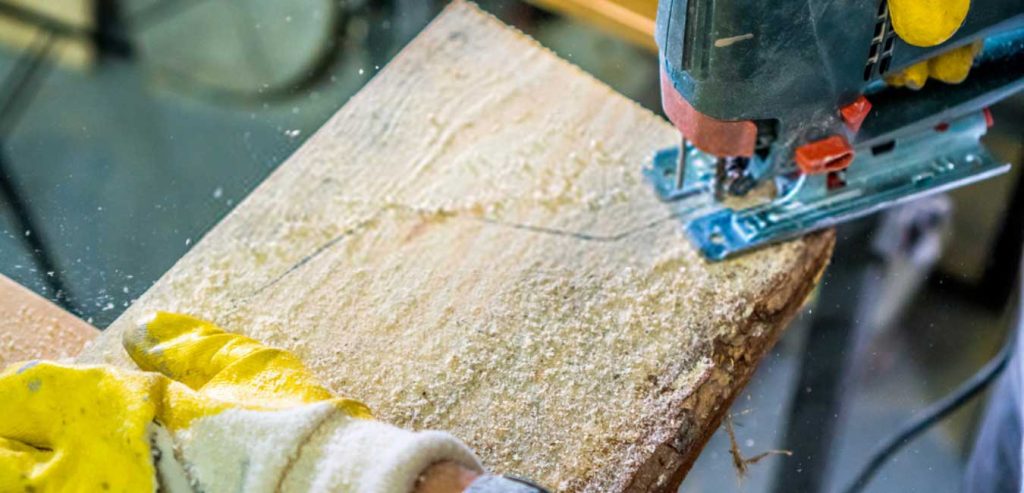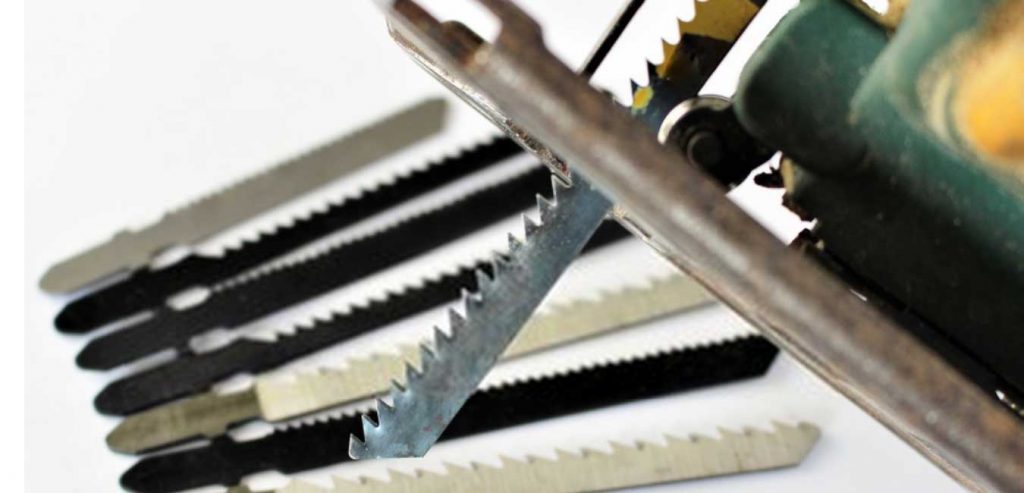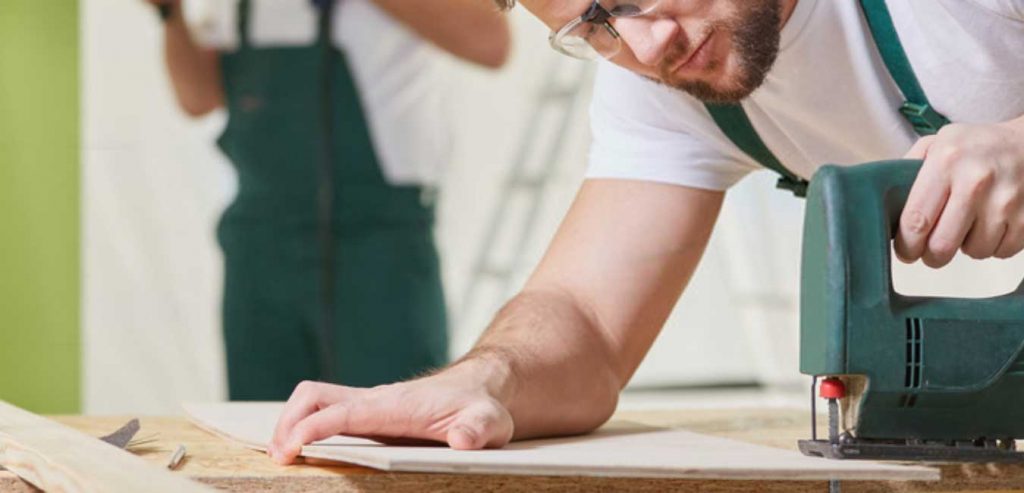A jigsaw is an essential tool in the inventory of any DIY enthusiast. It is a highly versatile tool that even a beginner can handle safely with no hassle. Despite the simple nature of the device, it can take care of a wide range of cutting applications in different materials such as wood, plastic, or even metal.
Assuming you are a novice in this line of work, and you have a jigsaw in your hand, you might be wondering how to get started with using this power tool.
To help you find your way, we have made this extensive guide detailing the nooks and crannies of using this device. So, without further delay, let us jump into how to use your jigsaw effectively.
Contents
What Is A Jigsaw, And Why Do You Need It?
Structurally, a jigsaw is a very straightforward, no-hassle tool. It comes with a blade on one end, a trigger to activate the unit, and some buttons or knobs to control the speed of the blade movement.
The control knobs allow you to change up your speed based on the material you are using for the project. For example, when you are making precise and delicate cuts, you want the cutting rate to be slow, but when it is not essential, you can go to town with speed.

The blade in the jigsaw is changeable, which allows you to cut a wide range of materials. You can also cut fiberglass or drywall if you use the right blade. This adjustable nature of the device makes it a vital element in any project. Changing the blade is also hassle-free, oftentimes not even requiring any tools.
Using this tool is not all that difficult or challenging. You can simply pull the integrated trigger, and the cutting will begin. However, there are some safety concerns and minor guidelines you should follow, especially if you are a beginner, to make the experience more pleasant.
Safety Tips While Using A Jigsaw
If you are someone who is regularly using a jigsaw for different work projects, you should familiarize yourself with a couple of safety practices. Above all, you need to ensure your safety while operating a power tool. Even a device as simple as a jigsaw could cause an accident if you do not treat it with proper respect and caution.

Here are a few safety tips and guidelines to help you get on your way to becoming an expert in using this tool.
- Do not use a jigsaw in a wet environment to prevent accidental electrocution
- Use an RCM circuit breaker when plugging in a power socket to avoid the risk of fire.
- Make sure there are no exposed part of the power cord when plugging in the jigsaw
- To help protect against lacerations, wear a Kevlar-lined glove
- Make sure you are using a sharp blade; dull blades are susceptible to kickbacks.
- Wear proper protective attires such as dust masks and safety goggles.
- Do not force the jigsaw to cut through stubborn materials. Instead, use the correct blade as per instructions.
- Read through the user manual thoroughly before using a jigsaw for the first time.
- Keep your instrument and the blade well-lubricated as required
- Be aware of your surroundings not to trip over while holding the jigsaw
Make sure there is no unauthorized personnel in the vicinity when operating the jigsaw.
Choosing the Correct Blade
The first step in using a jigsaw is selecting the right blade for the job. There are a few different types of blades available for this tool. Depending on the type of work and the material you are planning to cut, you need to switch it up.

Carbon Steel Blade
If you are planning to cut through wood and PVC, your best bet is to use a carbon steel blade. It is the most common blade found in most jigsaws and is considered standard for the tool.
Bi-Metal Blade
When cutting through thin metals, you should opt for a bi-metal blade. It is tougher than carbon steel and can cut through harder materials such as metals. This type of blade comes with hardened steel teeth and a flexible body to make cutting metals effortless.
Fine-Toothed Blade
For precise cuts, a fine-toothed blade is a perfect option. They feature more teeth per inch of the blade and can make clean, accurate cuts. One downside to this is that it makes the cutting process slower. But you end up with perfect cuts which are useful for working on delicate projects.
Coarse-Toothed Blade
For faster cuts, a coarse-toothed blade is the way to go. This type of blade comes with fewer teeth per inch and is mostly used in cutting wood. Because of fewer teeth, the cutting process is faster. However, the cut material will have rough surfaces when you are working with this type of blade.
Basics of How to Use a Jigsaw
Now that you know how to set up the jigsaw using the proper blade, it is time to dive into the actual cutting process. The following steps will show you how you can get started using your power tool.

Plug It In
First thing first, you need to plug the jigsaw power cord in the wall socket. If you are using a cordless Jigsaw model, put in the battery pack to get it up and running. Usually, cordless models are a better choice solely for not requiring a power outlet. Make sure to unplug the device whenever you are done using it.
Wear Protection
To keep your eyes protected, you need a pair of safety goggles. You also need a dust mask so that you do not inhale any dust and debris. Safety should never be overlooked when using a power tool, and a jigsaw is no different from this rule. You should adhere to all the safety steps we mentioned in the previous section.
Clamp Securely
Make sure you clamp down the material you are planning to cut. If it moves around, you will not be able to get the perfect output. To get the best results, you should use 2 C-clamps on the edge of your worktable and hold the material with it. If you need further stability, you can use additional clamps.
Pull the Trigger
Now that you are all prepped and ready to go, it is time to pull the trigger. The power trigger is usually located under the handle of the saw. Start the blade by squeezing it and keep it pressed until you are done the cutting. If your jigsaw comes with a lock switch, you do not need to keep the trigger held down all the time.
Speed Adjustment
Most jigsaws come with a speed adjustment option located on the front side of the machine. You can use it to dial in the proper rate at which you want the blade to cut. As a rule of thumb, faster speed will result in more jitters. If you are someone who is new, you should keep the pace slow to get a handle on the cutting process.
Plan Ahead
You should have a clear idea of the cut you are planning to make. For this purpose, you can use a pencil and a straightedge and etch out some marks along your required cutting points. It will serve as a guideline that you can follow along while making the cut with your jigsaw.
Additional Tips for Using a Jigsaw:
Blade Control on Start and End: To prevent splintering, gently lift the jigsaw blade slightly off the material as you begin and finish each cut. This minimizes rough edges and keeps the material intact.
Experiment with Blades and Speeds: Different jigsaw blades and speeds significantly impact how different materials are cut. To achieve the best results for each project, experiment with various blade types and speeds on sample pieces of your material.
Saw maintenance: Regular saw maintenance is essential for smooth, safe cutting. Keep blades sharp and clean, removing debris after each use. Check for loose parts, tighten screws, and lubricate moving components as recommended. It ensures your saw’s longevity and performance.
Practice for Precision: Try out your jigsaw on scrap pieces before cutting your main project, especially if you’re working with curves or using the plunge-cut technique. Practicing first helps you refine your control and boosts confidence.
Frequently Asked Questions (FAQ)
Here are some questions that we have seen most beginners ask and the answer to them to tackle some of the basic problems regarding jigsaw use.
How to maintain the power cord when using a jigsaw?
When you are using the jigsaw, you need to keep the power cord handled so that it does not get in the way of your process.
Tripping over it can cause serious accidents when you are holding your tool. Make sure the cord sticks behind the device at all times. You can wrap the wire around your hand to keep it locked in place.
Can a jigsaw be used upside down?
Yes, you can use your jigsaw upside down. In fact, when you are making a hole in the ceiling, you will often need to turn your device upside down to give yourself a better angle to cut.
Can I use my jigsaw to prune trees?
As long as the limbs are not too thick for the jigsaw, you can use it safely to prune trees. Keep in mind that a jigsaw is not designed for this purpose.
Generally, it is not recommended to use this machine to prune trees because you might end up damaging it. A Sawzall is a better tool for this purpose.
Final Thoughts
A jigsaw is a versatile tool in the hand of someone who knows how to use it. Thankfully, grasping the basics of using a jigsaw is not that difficult, and with proper practice and resilience, you can master it in no time.
Our extensive guide is a good place to start when learning how to use your tool. We hope we could help you find your way around the workshop with a jigsaw.